
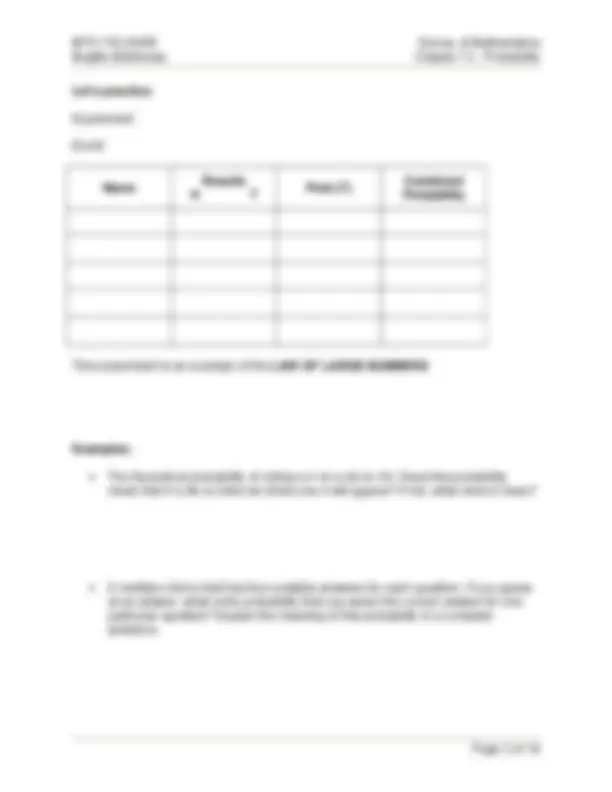
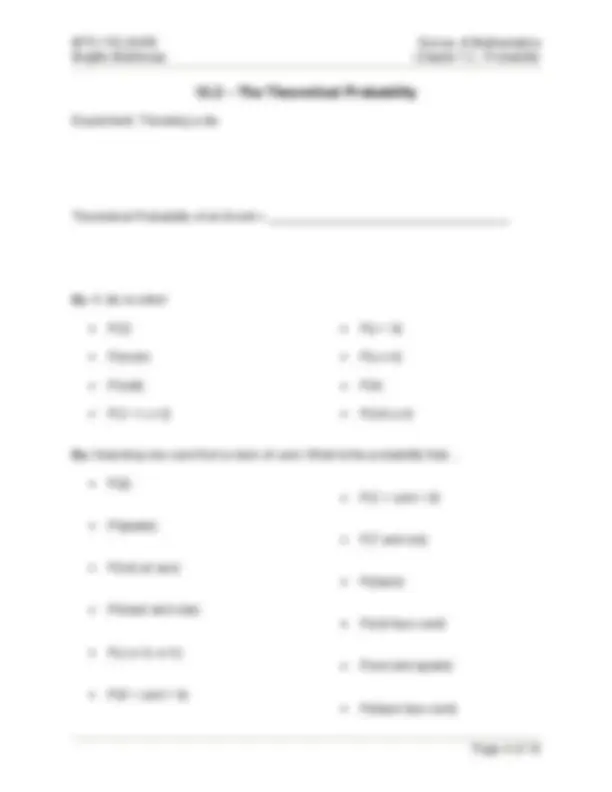
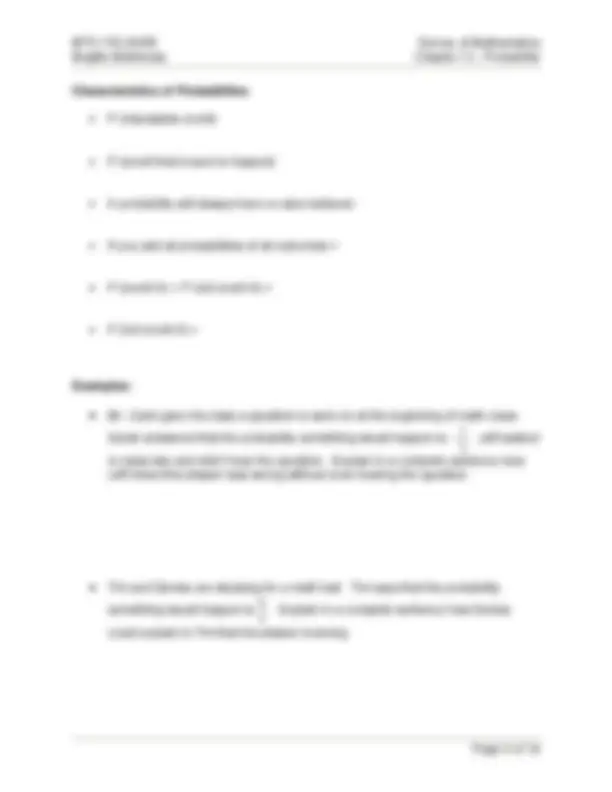
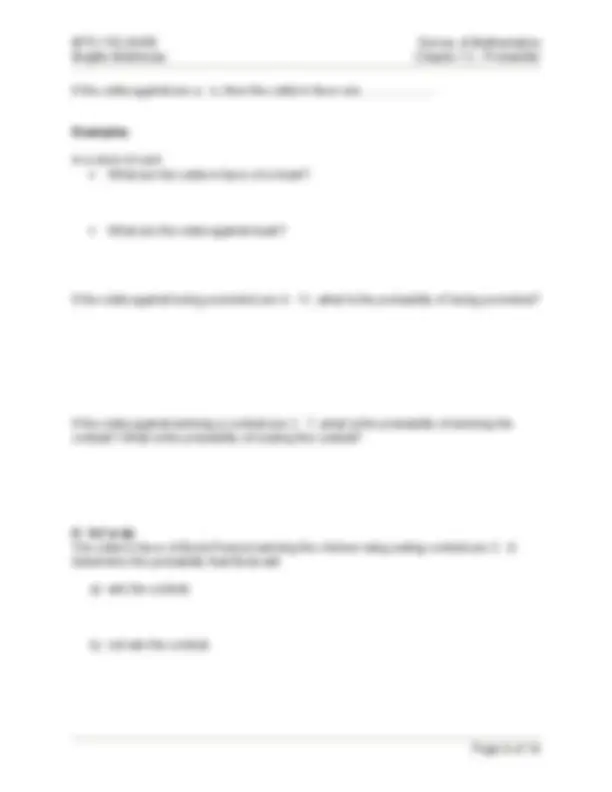
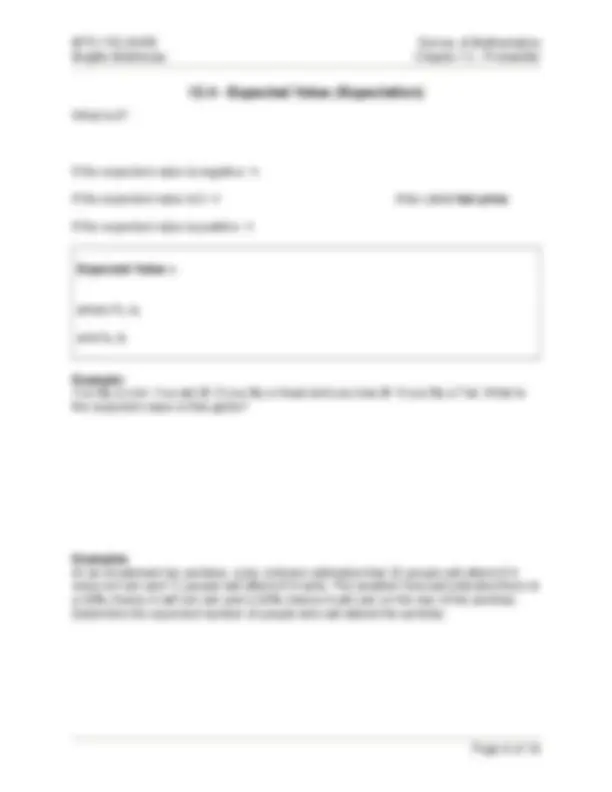
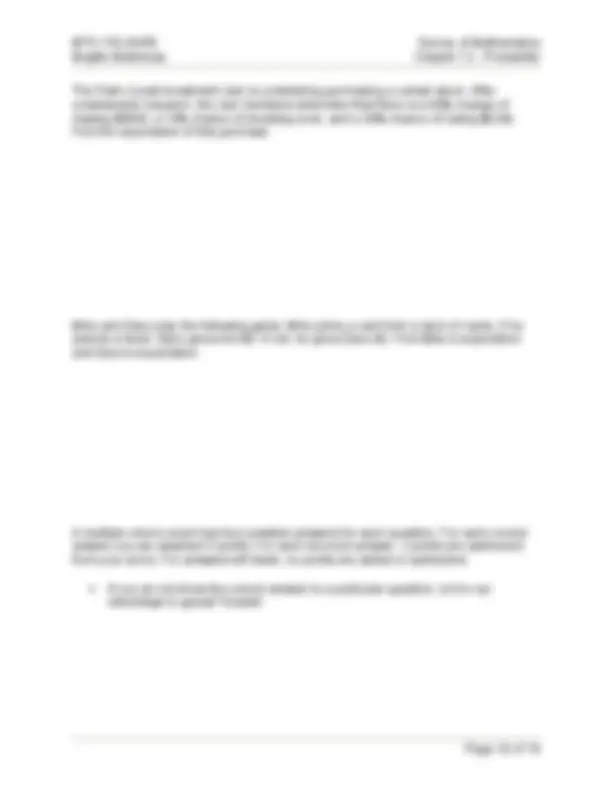
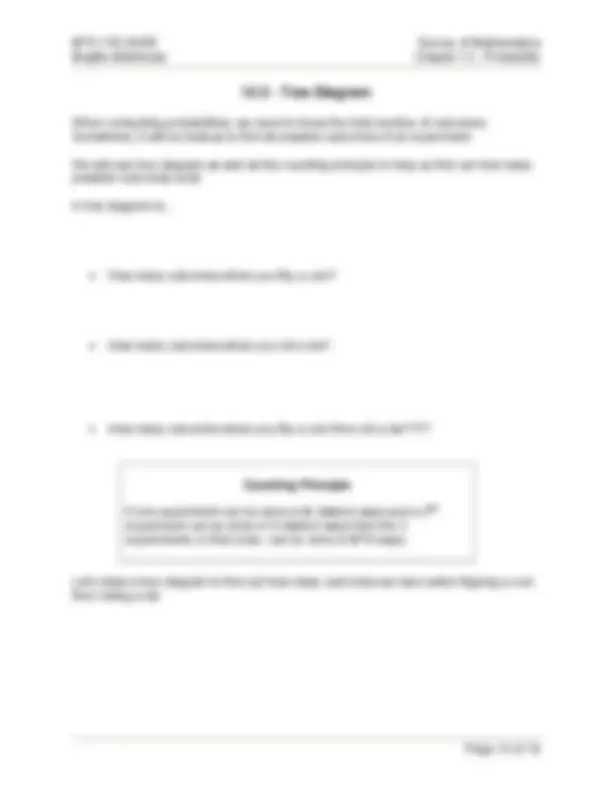
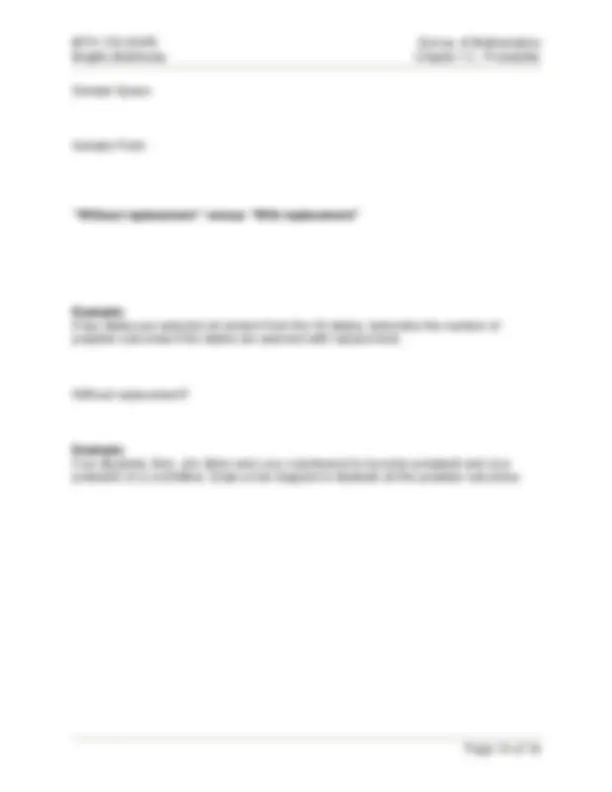
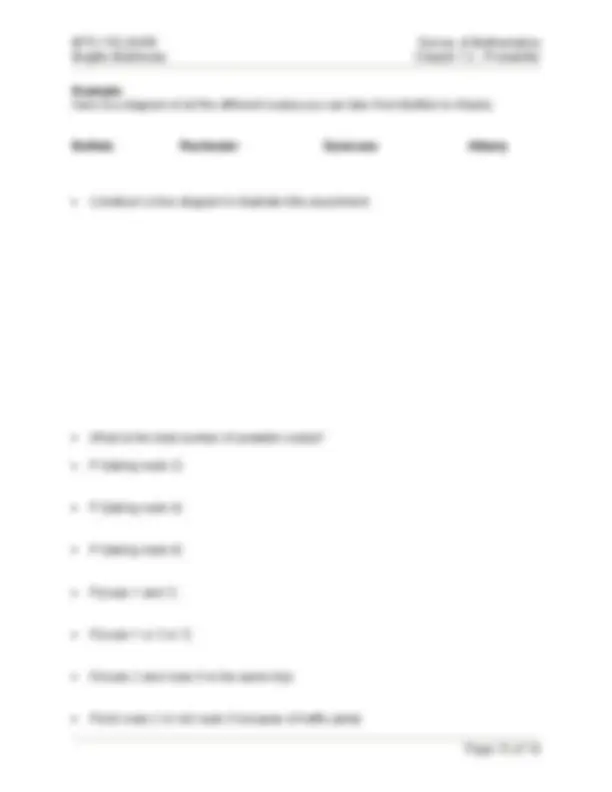
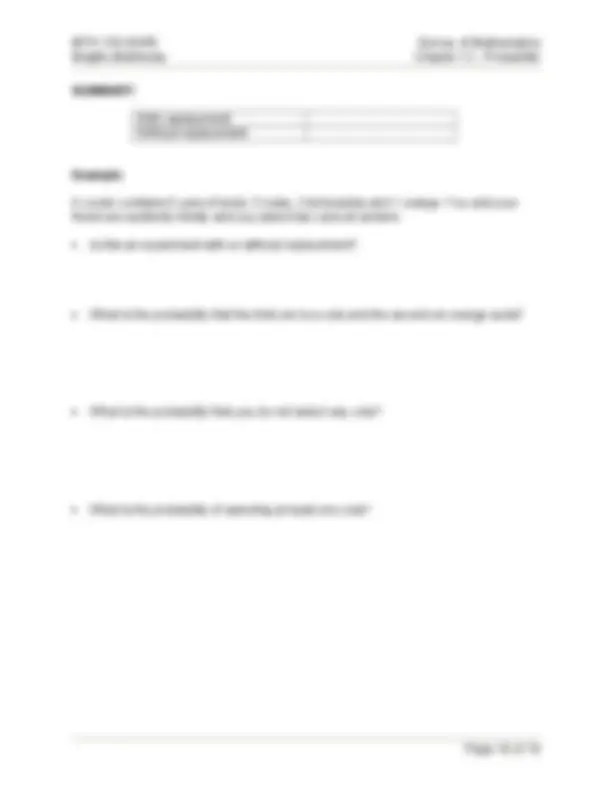
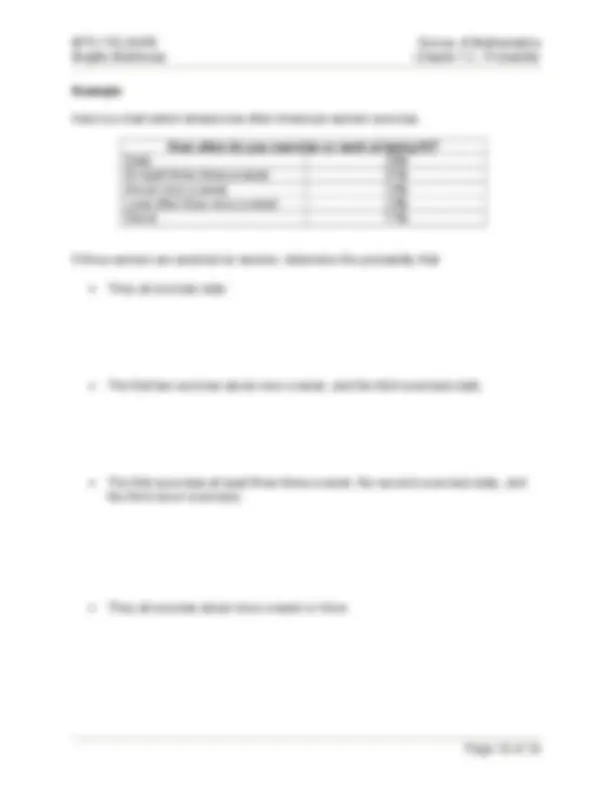


Study with the several resources on Docsity

Earn points by helping other students or get them with a premium plan


Prepare for your exams
Study with the several resources on Docsity

Earn points to download
Earn points by helping other students or get them with a premium plan
Community
Ask the community for help and clear up your study doubts
Discover the best universities in your country according to Docsity users
Free resources
Download our free guides on studying techniques, anxiety management strategies, and thesis advice from Docsity tutors
A chapter from a mathematics textbook titled 'survey of mathematics' by brigitte martineau. The chapter focuses on probability theory, covering topics such as the nature of probability, theoretical probability, odds, expected value, and tree diagrams. Exercises and examples to help students understand these concepts.
Typology: Study notes
1 / 19

This page cannot be seen from the preview
Don't miss anything!












Brigitte Martineau Chapter 12 - Probability
In which areas of your life have you heard or used probabilities lately?
Vocabulary
Experiment:
Outcomes:
Event:
Theoretical Probability versus Empirical Probability:
Empirical Probability of an event = ____________________________________
Brigitte Martineau Chapter 12 - Probability
Experiment: Throwing a die
Theoretical Probability of an Event = ____________________________________
Ex : A die is rolled
P(even)
P(odd)
P(2 < x ≤ 5)
P(x > 6)
P(x ≤ 6)
P(not a 4)
Ex: Selecting one card from a deck of card. What is the probability that…
P(spade)
P(not an ace)
P(heart and club)
P(J or Q or K)
P(8 < card < 9)
P(2 < card < 8)
P(7 and red)
P(black)
P(not face card)
P(red and spade)
P(black face card)
Brigitte Martineau Chapter 12 - Probability
Characteristics of Probabilities
P (impossible event)
P (event that is sure to happen)
A probability will always have a value between
If you add all probabilities of all outcomes =
P (event A) + P (not event A) =
P (not event A) =
Examples:
Sarah answered that the probability something would happen is
. Jeff walked
in class late and didn’t hear the question. Explain in a complete sentence how Jeff knew this answer was wrong without even hearing the question.
something would happen is 5
. Explain in a complete sentence how Denise
could explain to Tim that his answer is wrong.
Brigitte Martineau Chapter 12 - Probability
What does it mean?
Notation:
Odds against =
Odds in favor =
Widespread Misunderstanding
Examples
Roll a die
What are the odds against rolling an odd number?
What are the odds against rolling a number less than 3?
Brigitte Martineau Chapter 12 - Probability
If the odds against are a : b, then the odds in favor are ………………
Examples :
In a deck of card What are the odds in favor of a heart?
What are the odds against heart?
If the odds against being promoted are 4 : 11, what is the probability of being promoted?
If the odds against winning a contest are 2 : 7, what is the probability of winning the contest? What is the probability of loosing the contest?
The odds in favor of Boris Penzed winning the chicken wing eating contest are 3 : 8. Determine the probability that Boris will
a) win the contest
b) not win the contest
Brigitte Martineau Chapter 12 - Probability
The Palm Coast investment club is considering purchasing a certain stock. After considerable research, the club members determine that there is a 60% change of making $8000, a 10% chance of breaking even, and a 30% chance of losing $6200. Find the expectation of this purchase.
Mike and Dave play the following game: Mike picks a card from a deck of cards. If he selects a heart, Dave gives him $5. If not, he gives Dave $2. Find Mike’s expectation and Dave’s expectation.
A multiple-choice exam has four possible answers for each question. For each correct answer you are awarded 5 points. For each incorrect answer, 2 points are subtracted from your score. For answers left blank, no points are added or subtracted.
If you do not know the correct answer to a particular question, is it to our advantage to guess? Explain
Brigitte Martineau Chapter 12 - Probability
If you do not know the correct answer but can eliminate one possible choice, is it to your advantage to guess? Explain
This week, the expected number of viewers for the show Lost is 1.3 million people. Does this guarantee that next week there will be 1.3 million viewers for Lost? Explain your answer in complete sentences.
A poker player’s expectation is $10 for a hand of poker. Is it possible for this poker player to lose money on her next hand of poker? Explain your answer in complete sentences.
The concept of Fair Price
The fair price is the
Fair Price = Cost to Play + Expectation
Brigitte Martineau Chapter 12 - Probability
When computing probabilities, we need to know the total number of outcomes. Sometimes, it will be tedious to find all possible outcomes of an experiment.
We will use tree diagram as well as the counting principle to help us find out how many possible outcomes exist.
A tree diagram is…
How many outcomes when you flip a coin?
How many outcomes when you roll a die?
How many outcomes when you flip a coin then roll a die????
Counting Principle
If one experiment can be done in M distinct ways and a 2nd experiment can be done in N distinct ways then the 2 experiments, in that order, can be done in M*N ways.
Let’s draw a tree diagram to find out how many outcomes we have when flipping a coin then rolling a die
Brigitte Martineau Chapter 12 - Probability
Sample Space:
Sample Point:
“Without replacement” versus “With replacement”
Example: If two states are selected at random from the 50 states, determine the number of possible outcomes if the states are selected with replacement.
Without replacement?
Example: Four students, Bob, Jim, Mike and Lucy volunteered to become president and vice- president of a committee. Draw a tree diagram to illustrate all the possible outcomes.
Brigitte Martineau Chapter 12 - Probability
In the previous section we learned how to use tree diagrams to help us find the total number of outcomes. When the total number of outcomes is really large drawing tree diagram is not really useful!
In this section, we will try to solve OR and AND problems without using the tree diagram method.
Let’s look at an experiment we are familiar with…rolling a die.
Find P(odd or a number less than 5)
P(A or B) = P(A) + P(B) – P(A and B)
Examples
If P(A or B) = 0.6, P(B) = 0.3 and P(A and B) = 0.1, find P(A)
In a deck of card
Find P(red or 8) P(red or spades)
Two events are mutually exclusive if
Brigitte Martineau Chapter 12 - Probability
In AND Problems, two selections will occur one after another. You will select 2 cards, you will choose 2 students.
IT WILL ALWAYS INVOLVED 2 EVENTS FOLLOWED BY EACH OTHER.
P(A and B) = P(A) * P(B)
Assuming that event A has occurred
Examples :
In a deck of card, 2 cards are selected with replacement. Find the probability that you selected 2 face cards.
Is the probability of selecting a face on the second card affected by the fact that you selected a face card on the first selection?
What if the previous experiment was done without replacement?
Is the probability of selecting a face on the second card affected by the fact that you selected a face card on the first selection?
Brigitte Martineau Chapter 12 - Probability
Example
Here’s a chart which shows how often American women exercise.
How often do you exercise or work at being fit? Daily 20% At least three times a week 31% About once a week 15% Less often than once a week 23% Never 11%
If three women are selected at random, determine the probability that
They all exercise daily
The first two exercise about once a week, and the third exercises daily
The first exercises at least three times a week, the second exercises daily, and the third never exercises.
They all exercise about once a week or more.